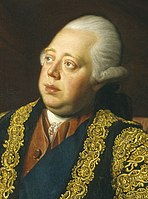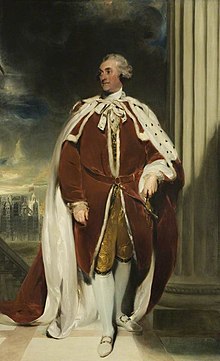Fox–North coalition
Fox–North coalition | |
|---|---|
 | |
| April–December 1783 | |
  Fox (left) and North (right) | |
| Date formed | 2 April 1783 |
| Date dissolved | 18 December 1783 |
| People and organisations | |
| Monarch | George III |
| Prime Minister | Duke of Portland |
| Secretaries of State | |
| Total no. of members | 15 appointments |
| Member parties | |
| Status in legislature | |
| Opposition party | |
| Opposition leaders | |
| History | |
| Legislature term | |
| Predecessor | Shelburne ministry |
| Successor | First Pitt ministry |
The Fox–North coalition was a government in Great Britain that held office during 1783.[1] As the name suggests, the ministry was a coalition of the groups supporting Charles James Fox and Lord North. The official head was William Cavendish-Bentinck, 3rd Duke of Portland, who took office on 2 April 1783.
Fox was a Whig by background, and North came from the nominal Tory Party; however, both had fallen out with the government of Lord Shelburne. They combined their forces in the House of Commons to throw out Shelburne's ministry and then form a government of their own.
King George III despised the government, and Fox in particular, but found that no other ministry could be formed at this stage despite several offers to William Pitt the Younger. Consequently, the King declined to provide the government with the normal tools of patronage, and it was forced to look elsewhere.
The Treaty of Paris was signed during this government on 3 September 1783, formally ending the American Revolutionary War. The government also came under strain when, from the opposition, Pitt introduced a proposal for electoral reform to tackle bribery and rotten boroughs. The proposal did not pass, but caused tensions within the coalition which contained both proponents and opponents of political reform.
The British East India Company was in trouble; Fox proposed nationalising it, thus providing the government with a new source of appointments so that it could reward and maintain support. The East India Bill was introduced and passed in the Commons, but the King remained deeply opposed. He informed the House of Lords that he would regard any peer who voted for the bill as his enemy. The bill was defeated on 17 December 1783 and the King immediately dismissed the coalition. It was succeeded by a government formed by William Pitt the Younger.
After being dismissed, Fox and North tried to force Pitt from power through defeat in the House of Commons, but he refused to resign. The response of opinion in the country, evidenced by petitions, resolutions of borough corporations and the actions of the London mobs, showed strong opposition to the coalition and support for Pitt. In March 1784 a general election was called in which Pitt's government made massive gains, especially in constituencies decided by popular votes.
Principal members of the government
[edit]
| Office | Name | Date |
|---|---|---|
| First Lord of the Treasury[2] | The Duke of Portland | 2 April 1783 |
| Secretary of State for the Home Department[3] | Lord North | 2 April 1783 |
| Secretary of State for Foreign Affairs[3] | Charles James Fox | 2 April 1783 |
| Lord President of the Council | The Viscount Stormont | 2 April 1783 |
| Lord Chancellor | In Commission | 9 April 1783 |
| Lord Privy Seal | The Earl of Carlisle | 2 April 1783 |
| First Lord of the Admiralty | The Viscount Keppel | 8 April 1783 |
| Chancellor of the Exchequer | Lord John Cavendish | 5 April 1783 |
| Master-General of the Ordnance | The Viscount Townshend | 28 April 1783[4] |
| First Lord of Trade | The Lord Grantham | continued in office |
| Chancellor of the Duchy of Lancaster | The Lord Ashburton | continued in office |
| The Earl of Derby | 29 April 1783 | |
| Treasurer of the Navy | Charles Townshend | 11 April 1783 |
| Secretary at War | Richard Fitzpatrick | 11 April 1783 |
| Paymaster of the Forces | Edmund Burke | 8 April 1783 |
| Lord Lieutenant of Ireland | The Earl of Northington | 1783 |

See also
[edit]References
[edit]- ^ Chris Cook and John Stevenson, British Historical Facts 1760–1830, Macmillan, 1980
- ^ also Leader of the House of Lords
- ^ a b also joint Leader of the House of Commons
- ^ Ordnance Masters 1544-1855 | Institute of Historical Research
Bibliography
[edit]- Black, Jeremy (2006). George III: America's Last King. Yale University Press. ISBN 0300117329.
- Pares, Richard (1953). King George III and the Politicians. London. Archived from the original on 20 August 2011. Retrieved 28 August 2017.
{{cite book}}: CS1 maint: location missing publisher (link) - Trevelyan, George Otto (1912). George the Third and Charles Fox: The Concluding Part of the American Revolution. Vol. 2 vols. – Online edition v2.
- Watson, J. Steven (1960). The Reign of George III, 1760–1815. – The standard scholarly history online edition Archived 22 August 2011 at the Wayback Machine.

